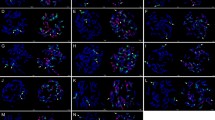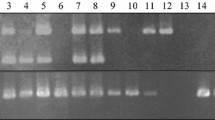Abstract
The screening of wild populations for evidence of gene flow from a crop to a wild related species requires the unambiguous detection of crop genes within the genome of the wild species, taking into account the intraspecific variability of each species. If the crop and wild relatives share a common ancestor, as is the case for the Brassica crops and their wild relatives (subtribe Brassiceae), the species-specific markers needed to make this unambiguous detection are difficult to identify. In the model oilseed rape (Brassica napus, AACC, 2n=38)-wild radish (Raphanus raphanistrum, RrRr, 2n=18) system, we utilized the presence or absence of a short-interspersed element (SINE) at a given locus to develop oilseed rape-specific markers, as SINE insertions are irreversible. By means of sequence-specific amplified polymorphism (SINE-SSAP) reactions, we identified and cloned 67 bands specific to the oilseed rape genome and absent from that of wild radish. Forty-seven PCR-specific markers were developed from three combinations of primers anchored either in (1) the 5′- and 3′-genomic sequences flanking the SINE, (2) the 5′-flanking and SINE internal sequences or (3) the SINE internal and flanking 3′-sequences. Seventeen markers were monomorphic whatever the oilseed rape varieties tested, whereas 30 revealed polymorphism and behaved either as dominant (17) or co-dominant (13) markers. Polymorphic markers were mapped on 19 genomic regions assigned to ten linkage groups. The markers developed will be efficient tools to trace the occurrence and frequency of introgressions of oilseed rape genomic region within wild radish populations.



Similar content being viewed by others
References
Baranger A, Chèvre AM, Eber F, Renard M (1995) Effect of oilseed rape genotype on the spontaneous hybridization rate with a weedy species: an assessment of transgene dispersal. Theor Appl Genet 91:956–963
Batzer MA, Stoneking M, Alegria-Hartman M, Bazan H, Kass DH, Shaikh TH, Novick GE, Ioannou PA, Scheer WD, Herrera RJ, Deininger PL (1994) African origin of human-specific polymorphic Alu insertions. Proc Natl Acad Sci USA 91:12288–12292
Capy P, Bazin C, Higuet D, Langin T (1998) Dynamics and evolution of transposable elements. Springer RG Landes, Austin
Cheng C, Motohashi R, Tsuchimoto S, Fukuta Y, Ohtsubo H, Ohtsubo E (2003) Polyphyletic origin of cultivated rice: based on the interspersion pattern of SINEs. Mol Biol Evol 20:67–75
Chèvre AM, Eber F, Darmency H, Fleury A, Picault H, Letanneur JC, Renard M (2000) Assessment of interspecific hybridization between transgenic oilseed rape and wild radish under normal agronomic conditions. Theor Appl Genet 100:1233–1239
Chèvre AM, Ammitzboll H, Breckling B, Dietz-Pfeilstetter A, Eber F, Fargue A, Gomez-Campo C, Jenczewski E, Jorgensen R, Lavigne C, Meier MS, den Nijs H, Pascher K, Seguin-Swartz G, Sweet J, Stewart CN Jr, Warwick S (2004) A review on interspecific gene flow from oilseed rape to wild relatives. In: Den Nuijs HCM, Bartsch D, Sweet J (eds) Introgression from genetically modified plants into wild relatives. CABI Publ, Wallingford, pp 235–251
Cook J, Tristem M (1997) SINEs of the times–transposable elements as clade markers for their hosts. Trends Ecol Evol 12:295–297
Darmency H, Lefol E, Fleury A (1998) Spontaneous hybridization between oilseed rape and wild radish. Mol Ecol 7:1467–1473
Delourme R, Foisset N, Horvais R, Barret P, Champagne G, Cheung WY, Landry BS, Renard M (1998) Characterisation of the radish introgression carrying the Rfo restorer gene for the Ogu-INRA cytoplasmic male sterility in rapeseed (Brassica napus L). Theor Appl Genet 97:129–134
Deragon JM, Landry BS, Pelissier T, Tutois S, Tourmente S, Picard G (1994) An analysis of retroposition in plants based on a family of SINEs from Brassica napus. J Mol Evol 39:378–386
Deragon JM, Gilbert N, Rouquet L, Lenoir A, Arnaud P, Picard G (1996) A transcriptional analysis of the S1Bn (Brassica napus) family of SINE retroposons. Plant Mol Biol 32:869–878
Doyle JJ, Doyle JL (1990) Isolation of plant DNA from fresh tissue. Focus 12:13–15
Eber F, Chèvre AM, Baranger A, Vallée P, Tanguy X, Renard M (1994) Spontaneous hybridization between a male-sterile oilseed rape and two weeds. Theor Appl Genet 88:362–368
Ellis TH, Poyser SJ, Knox MR, Vershinin AV, Ambrose MJ (1998) Polymorphism of insertion sites of Ty1-copia class retrotransposons and its use for linkage and diversity analysis in pea. Mol Gen Genet 260:9–19
Fourmann M, Barret P, Froger N, Baron C, Charlot F, Delourme R, Brunel D (2002) From Arabidopsis thaliana to Brassica napus: development of amplified concensus genetic markers (ACGM) for construction of a gene map. Theor Appl Genet 105:1196–1206
Gepts P, Papa R (2003) Possible effects of (trans)gene flow from crops on the genetic diversity from landraces and wild relatives. Environ Biosafety Res 2:89–103
James C (2004) Global status of commercialized Biotech/GM Crops:2004. ISAAA Briefs 32
Jenczewski E, Ronfort J, Chèvre AM (2003) Crop-to-wild gene flow, introgression and possible fitness effects of transgenes. Environ Biosafety Res 2:9–24
Jurka J, Klonowski P (1996) Integration of retroposable elements in mammals: selection of target sites. J Mol Evol 43:685–689
Kerlan MC, Chèvre AM, Eber F (1993) Interspecific hybrids between a transgenic rapeseed (Brassica napus) and related species: cytological characterization and detection of the transgene. Genome 36:1099–1106
Lenoir A, Cournoyer B, Warwick S, Picard G, Deragon JM (1997) Evolution of SINE S1 retroposons in Cruciferae plant species. Mol Biol Evol 14:934–941
Lenoir A, Pélissier T, Bousquet-Antonelli C, Deragon JM (2005) Comparative evolution history of SINEs in Arabidopsis thaliana and Brassica oleracea: Evidence for a high rate of SINE loss. Cytogenet Cell Genet 110 (in press)
Lincoln S, Daly M, Lander E (1992) Constructing genetic linkage maps with mapmaker/exp 3.0: a tutorial and reference manual, 3rd edn. Whitehead Institute Technical Report, Whitehead Technical Institute, Cambridge, Mass.
Lombard V, Delourme R (2001) A consensus linkage map for rapeseed (Brassica napus L): construction and integration of three individual maps from DH populations. Theor Appl Genet 103:491–507
Murata S, Takasaki N, Saitoh M, Okada N (1993) Determination of the phylogenetic relationships among Pacific salmonids by using short interspersed elements (SINEs) as temporal landmarks of evolution. Proc Natl Acad Sci USA 90:6995–6999
Okada N (1991) SINEs. Curr Opin Genet Dev 1:498–504
Parkin IAP, Sharpe AG, Keith DJ, Lydiate DJ (1995) Identification of the A and C genomes of amphidiploid Brassica napus (oilseed rape). Genome 38:1122–1131
Purugganan MD, Wessler SR (1995) Transposon signatures: species-specific molecular markers that utilize a class of multiple-copy nuclear DNA. Mol Ecol 4:265–269
Rieger MA, Potter TD, Preston C, Powles SB (2001) Hybridisation between Brassica napus L and Raphanus raphanistrum L under agronomic field conditions. Theor Appl Genet 103:555–560
Salem AH, Kilroy GE, Watkins WS, Jorde LB, Batzer MA (2003) Recently integrated Alu elements and human genomic diversity. Mol Biol Evol 20:1349–1361
Sambrook J, Russell DW (2001) Molecular cloning, 3rd edn. Cold Spring Harbor Laboratory Press, Plainview
Shedlock AM, Okada N (2000) SINE insertions: powerful tools for molecular systematics. Bioessays 22:148–160
Shimamura M, Yasue H, Ohshima K, Abe H, Kato H, Kishiro T, Goto M, Munechika I, Okada N (1997) Molecular evidence from retroposons that whales form a clade within even-toed ungulates. Nature 388:666–670
Song KT, Osborn C, Williams PH (1988) Brassica taxonomy based on nuclear restriction fragment length polymorphism (RFLPs). 1. Genome evolution of diploid and amphidiploid species. Theor Appl Genet 75:784–794
Tatout C, Lavie L, Deragon JM (1998) Similar target site selection occurs in integration of plant and mammalian retroposons. J Mol Evol 47:463–470
Tatout C, Warwick SI, Lenoir A, Deragon JM (1999) SINE insertion as clade markers for wild Cruciferae species. Mol Biol Evol 16:1614–1621
Udall J, Quijada P, Osborn TC (2005) Detection of chromosomal rearrangements derived from homoeologous recombination in four mapping populations of Brassica napus L. Genetics 169:967–979
Warwick SI, Black LD (1991) Molecular systematics of Brassica and allied genera (subtribe Brassicinae, Brassiceae)—chloroplast genome and cytodeme congruence. Theor Appl Genet 82:81–92
Warwick SI, Black LD (1993) Molecular relationships in subtribe Brassicinae (Cruciferae, tribe Brassiceae). Can J Bot 71:906–918
Warwick SI, Simard MJ, Légère A, Beckie HJ, Braun L, Zhu B, Mason P, Séguin-Swartz G, Stewart JCN (2003) Hybridization between transgenic Brassica napus L and its wild relatives: B rapa L, Raphanus raphanistrum L, Sinapis arvensis L, and Erucastrum gallicum (Willd) OE Schulz. Theor Appl Genet 3:528–539
Waugh R, McLean K, Flavell AJ, Pearce SR, Kumar A, Thomas BB, Powell W (1997) Genetic distribution of Bare-1-like retrotransposable elements in the barley genome revealed by sequence-specific amplification polymorphisms (S-SAP). Mol Gen Genet 253:687–694
Acknowledgements
The work was supported by a post-doc grant of the National Institute of Agronomic Research and was funded by the French Research Ministry (Contract no. C002001).
Author information
Authors and Affiliations
Corresponding author
Additional information
Communicated by C. Möllers
Rights and permissions
About this article
Cite this article
Prieto, J.L., Pouilly, N., Jenczewski, E. et al. Development of crop-specific transposable element (SINE) markers for studying gene flow from oilseed rape to wild radish. Theor Appl Genet 111, 446–455 (2005). https://doi.org/10.1007/s00122-005-2017-5
Received:
Accepted:
Published:
Issue Date:
DOI: https://doi.org/10.1007/s00122-005-2017-5




